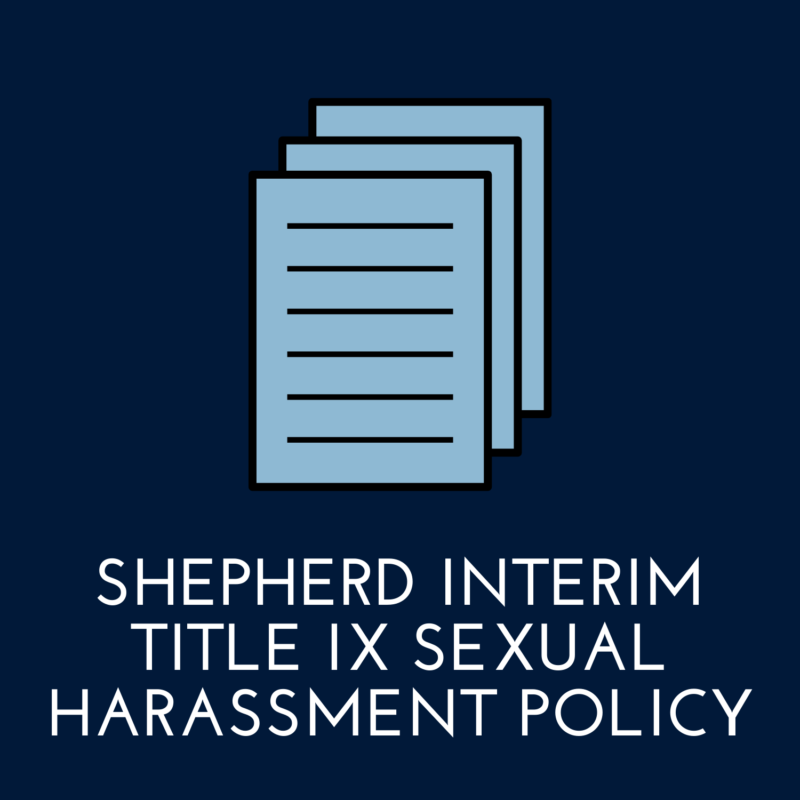Shepherd Interim Title IX Sexual Harassment Policy

Prohibited Forms of Conduct: The University prohibits all forms of harassment or discrimination on the basis of sex, including sexual harassment as defined below.
Sexual harassment means conduct on the basis of sex that satisfies one or more of the following:
1. An employee of the University conditioning the provision of an aid, benefit, or service of the University on an individual’s participation in unwelcome sexual conduct (Quid Pro Quo);
- Quid pro quo conduct examples:
- Direct propositions of a sexual nature between those for whom a power imbalance or supervisory or other authority relationship exists
- Offering employment benefits in exchange for sexual favors
- Making submission to sexual advances an actual or implied condition of employment, work status, promotion, grades, or letters of recommendation, including subtle pressure for sexual activity, an element of which may be repeated requests for private meetings with no academic or work purpose
- Making or threatening reprisals after a negative response to sexual advances
2. Unwelcome conduct determined by a reasonable person to be so severe, pervasive, and objectively offensive that it effectively denies a person equal access to the recipient’s education program or activity (Hostile Environment); or
Examples of conduct that may constitute sexual harassment as defined above may include a severe, persistent and pervasive pattern of unwelcome conduct that includes one or more of the following:
- Physical conduct:
- Unwelcome touching, sexual/physical assault, impeding, restraining, or blocking movements
- Unwanted sexual advances within the employment context
- Verbal conduct:
- Verbal abuse of a sexual nature, graphic verbal commentaries about an individual’s body, sexually degrading words used to describe an individual
- Objectively offensive comments of a sexual nature, including persistent and pervasive sexually explicit statements, questions, jokes, or anecdotes
- Visual conduct:
- Severe, persistent, and pervasive visual displays of suggestive, erotic, or degrading sexually oriented images that are not pedagogically appropriate
- Written conduct:
- Letters, notes, or electronic communications containing comments, words, or images described above
Hostile Environment examples above may fit the definition depending on circumstances.
3. Sexual and Intimate Partner Violence as defined below:
A. Sexual assault: Any sexual act directed against another person, without the consent of the victim, including instances where the victim is incapable of giving consent.
- Non-consensual Sexual Contact/Fondling: the intentional touching of the private body parts of another person for the purpose of sexual gratification, without the consent of the victim, including instances where the victim is incapable of giving consent because of his/her age and/or because of his/her temporary or permanent mental incapacity.
- Non-consensual Sexual Intercourse/Rape: the penetration, no matter how slight, of the vagina or anus with any body part or object, or oral penetration by a sex organ of another person, without the consent of the victim.
- Incest, including non-forcible sexual intercourse between persons who are related to each other within the degrees wherein marriage, is prohibited by law.
- Statutory Rape, including non-forcible sexual intercourse with a person who is under the statutory age of consent.
B. Dating Violence: Violence committed by a person who is or has been in a social relationship of a romantic or intimate nature with the victim.
- The existence of such a relationship shall be determined based on the reporting party’s statement and with consideration of the length of the relationship, the type of relationship, and the frequency of interaction between the persons involved in the relationship.
- For the purposes of this definition, dating violence includes, but is not limited to, sexual or physical abuse or the threat of such abuse.
- Dating violence does not include acts covered under the definition of domestic violence.
C. Domestic Violence: A felony or misdemeanor crime of violence committed:
- By a current or former spouse or intimate partner of the victim;
- By a person with whom the victim shares a child in common;
- By a person who is cohabitating with, or has cohabitated with, the victim as a spouse or intimate partner;
- By a person similarly situated to a spouse of the victim under the domestic or family violence laws of the jurisdiction in which the crime of violence occurred;
- By any other person against an adult or youth victim who is protected from that person’s acts under the domestic or family violence laws of the jurisdiction in which the crime of violence occurred.
D. Stalking, includes engaging in a course of conduct directed at a specific person that would cause a reasonable person to:
- Fear for the person’s safety or the safety of others; or
- Suffer substantial emotional distress.
For the purposes of this definition:
- Course of conduct means two or more acts, including, but not limited to, acts in which the stalker directly, indirectly, or through third parties, by any action, method, device, or means, follows, monitors, observes, threatens, or communicates to or about a person, or interferes with a person’s property.
- Reasonable person means a reasonable person under similar circumstances and with similar identities to the victim.
- Substantial emotional distress means significant mental suffering or anguish that may, but does not necessarily, require medical or other professional treatment or counseling.
E. Retaliation: intimidating, threatening, coercing, or discriminating against any individual for the purpose of interfering with any right or privilege secured by Title IX, or because the individual has made a report or complain, testifies, assisted, or participated ore refused to participate in any manner in an investigation, or hearing under Title IX.
Other Definitions
Consent: Consent is a knowing, voluntary, and mutual agreement to engage in sexual activity. Consent can be given by words or actions, as long as those words or actions create clear, unambiguous permission regarding willingness to engage in sexual activity.
- Consent is active, not passive. Silence, passivity, or lack of resistance does not imply consent.
- Consent to engage in one form of sexual activity does not imply consent to engage in other forms of sexual activity.
- Consent to engage in sexual activity with one person does not imply consent to engage in sexual activity with another.
- Past consent does not imply future consent.
- Consent is required regardless of whether the person initiating the act is under the influence of drugs and/or alcohol.
- Consent cannot be given when it is the result of coercion, intimidation, force, threat of harm, or when a person is mentally or physically incapacitated.
- Incapacitation can occur as a result of mental disability, sleep, involuntary physical restraint, unconsciousness, voluntary (or involuntary) use of alcohol and/or drugs, or when a person is otherwise physically helpless.
- When consent is withdrawn or can no longer be given, sexual activity must stop.
The definition of consent does not vary based upon a participant’s sex, sexual orientation, gender identity, or gender expression.
Incapacitation: An incapacitated individual is unable to make rational, reasonable decisions (e.g. to understand the fact, nature, or extent of the sexual interaction) and therefore is incapable of giving consent. Consent cannot be gained by taking advantage of the incapacitation of another, where the person initiating sexual activity knew or reasonably should have known that the other was incapacitated.
Incapacitation may result from the use of alcohol and/or drugs. The impact of alcohol and drugs varies from person to person; however, warning signs that a person may be approaching incapacitation may include but are not limited to slurred speech, vomiting, unsteady gait, odor of alcohol, combativeness, emotional volatility, lack of control over physical movements, and inability to communicate.
Force: Force is the use or threat of physical violence and/or imposing on someone physically to gain sexual access. Force also includes threats, intimidation (implied threats), and coercion that overcomes an individual’s free will to choose whether or not to participate in sexual activity.
Coercion: Coercion is the improper use of pressure to compel another individual to initiate or continue sexual activity. Coercion occurs when a person intimidates, forces, or manipulates someone into engaging in sexual activity without the use of physical force. Manipulative statements, threats of violence, blackmail, drugs, and/or alcohol can be used to coerce another into sexual activity. A person’s words or conduct are sufficient to constitute coercion if another individual’s freedom of will and ability to choose whether or not to engage in sexual activity is impaired. Use of alcohol as a tool to engage another, sexually, will be a factor in determining coercion and consent. A person’s age and level of experience compared to another will also be used as a factor in determining whether sexual activity has been consensual.
Warning: In general, the University considers sexual contact while under the influence of alcohol or other drugs to be risky behavior. Alcohol and drugs can impair a person’s decision-making capacity, awareness of consequences, and ability to make informed judgments. It is especially important, therefore, that anyone engaging in sexual activity be aware of the other person’s level of intoxication. If there is any doubt as to the level or extent of the other individual’s intoxication, the prudent course of action is to forgo or cease any sexual contact or activity.
Intoxication or impairment through the use of drugs or alcohol is never an excuse for sexual harassment, misconduct, or interpersonal violence and does not diminish one’s responsibility to obtain informed and freely given consent.



